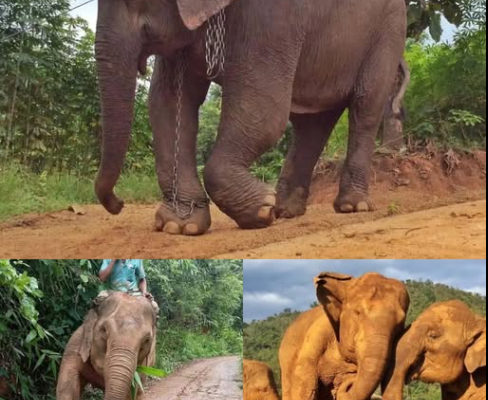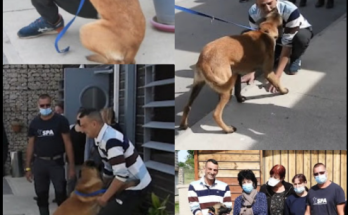For more than twenty years, KaBu the elephant knew only one kind of life — one defined by ropes, commands, pain, and exhaustion. He wasn’t born into captivity; he was dragged into it. And from that moment on, everything about his existence became work.
Heavy, endless work.

At dawn he carried tourists. At noon he hauled logs up mountainsides. At dusk he was forced to march through villages, his tired feet stepping over concrete and broken glass. And at night, while other elephants should have been sleeping in cool forests under the moonlit canopy, KaBu stood tethered to a pole by a short chain wrapped around his ankle — so tight it rubbed raw into skin that never fully healed.
People saw an elephant working.
No one saw the elephant suffering.

But suffering shaped every part of KaBu’s life. His spine carried the scars of heavy loads. His legs trembled from years of strain. His eyes, once bright and curious, had dimmed from trauma. He bore not only physical wounds, but emotional ones — the kind that come from isolation, fear, and never knowing gentleness.
For two decades, KaBu survived a world that did not see him.
Until, finally, someone did.
The Day That Changed Everything
It started with a whisper — a rumor reaching the ears of a wildlife rescue team about an elephant who had spent most of his life in chains. They were told he was aging, limping, and still being forced to work.

The team had rescued many elephants before, but something about KaBu’s story gripped them deeply. Maybe it was the length of his suffering. Maybe it was how little time he had left. Maybe it was the feeling that he had been waiting his entire life for someone to step forward.
They gathered veterinarians, transport specialists, conservationists, and volunteers. They studied maps, estimated risks, and prepared for what would be an emotionally complex mission — freeing an elephant who had known nothing but captivity, and giving him something he had never tasted:
Freedom.

On the morning the team arrived, KaBu was working — or trying to. His limp was worse. His ribs showed. He had stopped eating well. Survival had replaced living.
When the rescuers approached, the owner clutched the rope around KaBu’s neck, suspicious and defensive. It took hours of tense negotiation, raised voices, and heart-pounding uncertainty. But eventually, unbelievably, the owner loosened his grip…
…and let go.
KaBu did not understand the significance of that moment.
But the rescuers did.
It was his last day in chains.

Breaking the Chain
The first thing the team did wasn’t medical treatment — it was kindness.
A gentle hand on KaBu’s cheek.
A soft voice calling his name.
A basket of fresh fruit held out with patience.
KaBu hesitated. Fear had been his teacher for twenty years. But then, for the first time in a very long time, he reached out his trunk and accepted food freely — without punishment, without force.

Then came the moment that no one ever forgets.
A rescuer knelt, touched the rusted chain locked around KaBu’s leg, and began to cut.
It took several tries.
The metal was old but stubborn — like the suffering it represented.
With a final sharp crack, the chain fell open and dropped to the ground.
KaBu flinched.
The rescuers held still.

And then, realizing nothing would hurt him, KaBu slowly lifted his foot — the same way a prisoner tests the air outside a cell for the first time.
One rescuer later said, voice breaking,
“It was like watching a soul take its first breath.”
The Journey Toward Healing
Transporting KaBu to the rescue center was slow. His limp was severe, and the emotional weight of unfamiliar freedom made him hesitant. But every few minutes, a rescuer walked beside him, speaking softly, reassuring him that this path — for the first time in his life — led to safety.
When KaBu arrived at the sanctuary, his world changed instantly.

No chains.
No shouting.
No forced labor.
Just open fields, gentle caretakers, and other elephants — some with stories as painful as his own.
At first, he kept to himself. He slept standing, unsure if lying down would be safe. He ate cautiously. He watched the other elephants like someone who had forgotten what trust looked like.
But healing has its own quiet timeline.

Within weeks:
• His limp began improving with physical therapy.
• His appetite returned.
• His eyes softened.
• He reached his trunk toward his caretakers voluntarily.
• He let out his first playful rumble — a sound some staff cried hearing.
The sanctuary staff described him as “a spirit slowly remembering it was born wild.”
The World Meets KaBu

Word of KaBu’s rescue spread quickly across social media. Photos and videos of him taking his first free steps went viral. Hashtags formed. Messages poured in from every corner of the world:
“Thank you for saving him.”
“He deserves every moment of peace.”
“He’s waited too long for this.”
People shared their own stories of healing, of breaking free from painful pasts, of rebuilding their lives. KaBu became more than an elephant — he became a symbol of survival, of hope, of the belief that even after years of cruelty, life can begin again.
And thousands who had never heard his name before now rooted for him every day.

Why KaBu’s Story Matters
KaBu’s journey is not just about one elephant.
It’s about the thousands still carrying heavy logs.
Still giving tourist rides.
Still living in chains.
Still waiting.

His freedom shines a light on the larger fight for ethical elephant treatment, conservation, and the end of cruelty disguised as tradition or entertainment.
KaBu shows us that:
• Recovery is possible.
• Compassion is powerful.
• Change begins when someone decides to act.
And that every life — human or animal — deserves dignity.

A Future Finally His Own
Today, KaBu roams his sanctuary with calm footsteps. He grazes when he wants, rests when he chooses, and lifts his trunk to the sky during cool mornings as though greeting a world he’s finally allowed to enjoy.
He will never return to chains.
He will never be forced to work again.
He will grow old in peace — as every elephant should.

KaBu’s story is a reminder that healing often starts with a single act of courage… and continues with a world willing to care.
His freedom is not just a rescue.
It is a promise —
that no creature is too broken to begin again.




